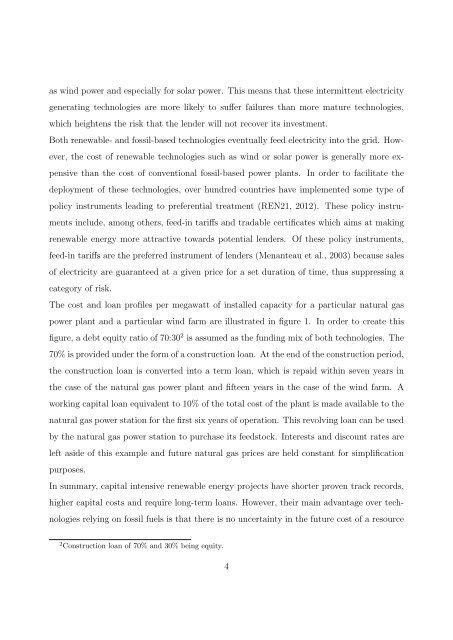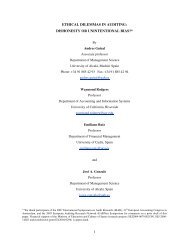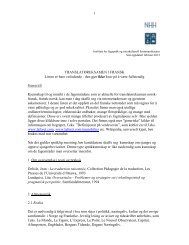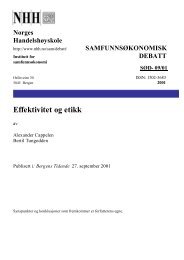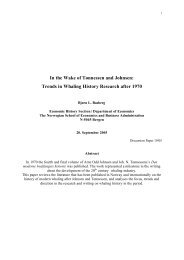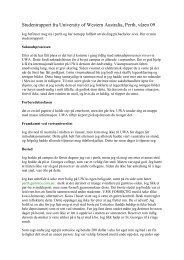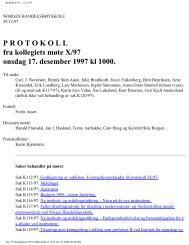The likely impact of Basel III on a bank's appetite for ... - NHH
The likely impact of Basel III on a bank's appetite for ... - NHH
The likely impact of Basel III on a bank's appetite for ... - NHH
You also want an ePaper? Increase the reach of your titles
YUMPU automatically turns print PDFs into web optimized ePapers that Google loves.
as wind power and especially <strong>for</strong> solar power. This means that these intermittent electricitygenerating technologies are more <str<strong>on</strong>g>likely</str<strong>on</strong>g> to suffer failures than more mature technologies,which heightens the risk that the lender will not recover its investment.Both renewable- and fossil-based technologies eventually feed electricity into the grid. However,the cost <str<strong>on</strong>g>of</str<strong>on</strong>g> renewable technologies such as wind or solar power is generally more expensivethan the cost <str<strong>on</strong>g>of</str<strong>on</strong>g> c<strong>on</strong>venti<strong>on</strong>al fossil-based power plants. In order to facilitate thedeployment <str<strong>on</strong>g>of</str<strong>on</strong>g> these technologies, over hundred countries have implemented some type <str<strong>on</strong>g>of</str<strong>on</strong>g>policy instruments leading to preferential treatment (REN21, 2012). <str<strong>on</strong>g>The</str<strong>on</strong>g>se policy instrumentsinclude, am<strong>on</strong>g others, feed-in tariffs and tradable certificates which aims at makingrenewable energy more attractive towards potential lenders. Of these policy instruments,feed-in tariffs are the preferred instrument <str<strong>on</strong>g>of</str<strong>on</strong>g> lenders (Menanteau et al., 2003) because sales<str<strong>on</strong>g>of</str<strong>on</strong>g> electricity are guaranteed at a given price <strong>for</strong> a set durati<strong>on</strong> <str<strong>on</strong>g>of</str<strong>on</strong>g> time, thus suppressing acategory <str<strong>on</strong>g>of</str<strong>on</strong>g> risk.<str<strong>on</strong>g>The</str<strong>on</strong>g> cost and loan pr<str<strong>on</strong>g>of</str<strong>on</strong>g>iles per megawatt <str<strong>on</strong>g>of</str<strong>on</strong>g> installed capacity <strong>for</strong> a particular natural gaspower plant and a particular wind farm are illustrated in figure 1. In order to create thisfigure, a debt equity ratio <str<strong>on</strong>g>of</str<strong>on</strong>g> 70:30 2 is assumed as the funding mix <str<strong>on</strong>g>of</str<strong>on</strong>g> both technologies. <str<strong>on</strong>g>The</str<strong>on</strong>g>70% is provided under the <strong>for</strong>m <str<strong>on</strong>g>of</str<strong>on</strong>g> a c<strong>on</strong>structi<strong>on</strong> loan. At the end <str<strong>on</strong>g>of</str<strong>on</strong>g> the c<strong>on</strong>structi<strong>on</strong> period,the c<strong>on</strong>structi<strong>on</strong> loan is c<strong>on</strong>verted into a term loan, which is repaid within seven years inthe case <str<strong>on</strong>g>of</str<strong>on</strong>g> the natural gas power plant and fifteen years in the case <str<strong>on</strong>g>of</str<strong>on</strong>g> the wind farm. Aworking capital loan equivalent to 10% <str<strong>on</strong>g>of</str<strong>on</strong>g> the total cost <str<strong>on</strong>g>of</str<strong>on</strong>g> the plant is made available to thenatural gas power stati<strong>on</strong> <strong>for</strong> the first six years <str<strong>on</strong>g>of</str<strong>on</strong>g> operati<strong>on</strong>. This revolving loan can be usedby the natural gas power stati<strong>on</strong> to purchase its feedstock. Interests and discount rates areleft aside <str<strong>on</strong>g>of</str<strong>on</strong>g> this example and future natural gas prices are held c<strong>on</strong>stant <strong>for</strong> simplificati<strong>on</strong>purposes.In summary, capital intensive renewable energy projects have shorter proven track records,higher capital costs and require l<strong>on</strong>g-term loans. However, their main advantage over technologiesrelying <strong>on</strong> fossil fuels is that there is no uncertainty in the future cost <str<strong>on</strong>g>of</str<strong>on</strong>g> a resource2 C<strong>on</strong>structi<strong>on</strong> loan <str<strong>on</strong>g>of</str<strong>on</strong>g> 70% and 30% being equity.4


